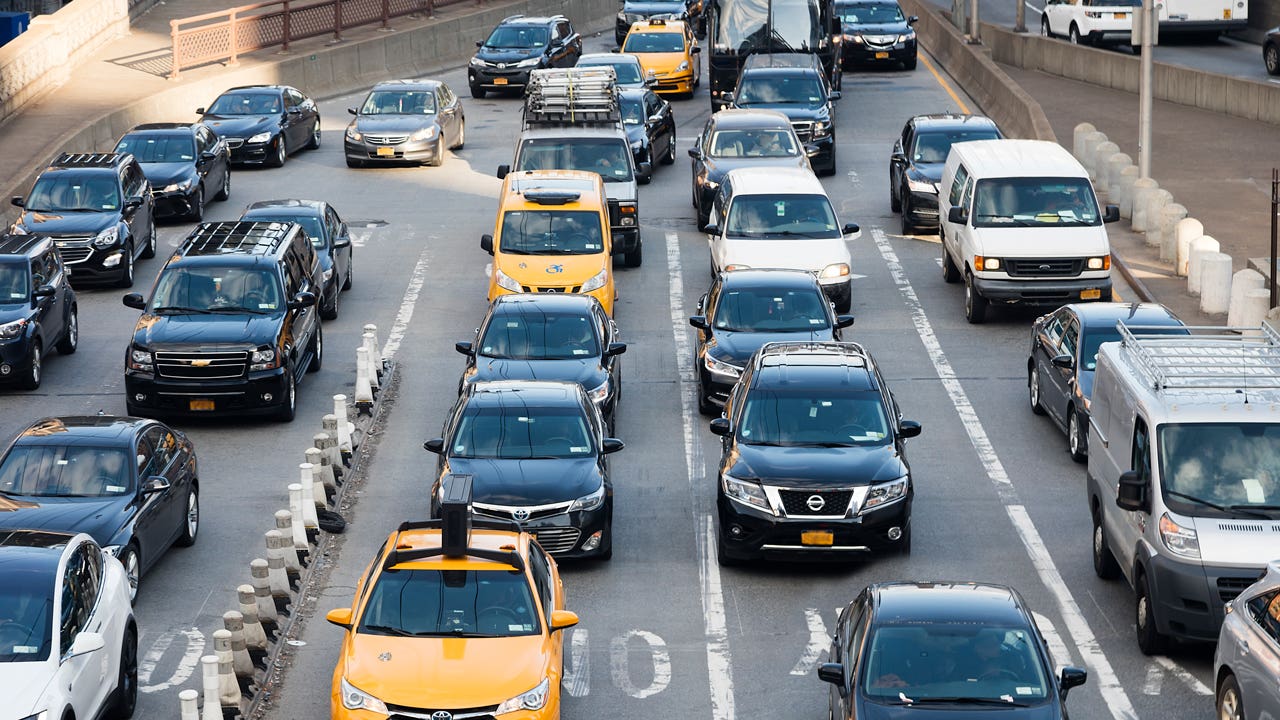Car insurance for high-risk drivers in New York

The Bankrate promise
At Bankrate, we strive to help you make smarter financial decisions. To help readers understand how insurance affects their finances, we have licensed insurance professionals on staff who have spent a combined 47 years in the auto, home and life insurance industries. While we adhere to strict , this post may contain references to products from our partners. Here's an explanation of . Our content is backed by Coverage.com, LLC, a licensed entity (NPN: 19966249). For more information, please see our .
If you live in the state of New York and have a history of traffic violations or accidents, you may be considered a high-risk driver. Bankrate defines a high-risk driver as someone with at least one speeding ticket conviction, at-fault accident or DUI conviction on their motor vehicle record. Drivers with poor driving records are more likely to file claims. To compensate for the added risk, insurers tend to charge these drivers higher car insurance premiums. In addition to other factors, the type of incident and severity will determine how much your car insurance premium increases. Bankrate can help high-risk drivers in New York understand how their driving history impacts auto insurance quotes, using premium data from Quadrant Information Services.
Rates for high-risk car insurance in New York
Each insurance provider uses its own underwriting formula to calculate a driver’s risk. The rates you pay for high-risk car insurance in New York will vary by each insurance company, as well as the type of violation(s) associated with your driving record and the frequency or severity of those violations. For instance, most companies would not consider a speeding ticket as serious of a violation as a DUI conviction, so rate increases for a speeding ticket may be marginal in comparison. However, if you already have one speeding ticket and receive another, your rates could increase to a greater degree than for someone with a single DUI conviction or at-fault accident.
Rates after a speeding ticket
Rates typically increase after a speeding ticket conviction. Additionally, you will likely have to pay a fine or your license may be revoked, especially if you receive subsequent convictions in an 18-month period. How fast you were driving over the speed limit and having multiple speeding ticket convictions can also cause steeper insurance premium increases. However, if your speeding ticket is dismissed, your rate should stay the same.
The table below shows examples of increases from three insurance companies, with Progressive showing the smallest increase of just 1 percent on average and Travelers showing the greatest increase of 8 percent on average.
New York average annual full coverage premium
| Car insurance company | Rate before a speeding ticket conviction | Rate after a speeding ticket conviction | % increase |
|---|---|---|---|
| Geico | $2,461 | $2,583 | 5% |
| Progressive | $1,942 | $1,966 | 1% |
| Travelers | $3,369 | $3,653 | 8% |
Notice how the increase is not standardized across insurance agencies. If you are unhappy with your rates following a speeding ticket, shopping around may help you discover if lower rates are available from another insurer.
Rates after an at-fault accident
There are several types of car accidents that can happen. You may be involved in a simple fender bender with no resulting injuries or significant damages, or an accident that results in multiple damaged vehicles and severe medical injuries. In any case, being found at-fault for a collision can have a substantial impact on your rates.
The rates in the table below indicate potential increases to insurance rates for a New Yorker with an at-fault collision on their motor vehicle record, with Progressive showing the smallest average increase at 2 percent and Travelers showing the largest average increase at 8 percent. Your rate could also be affected if you are convicted of a moving violation as part of the at-fault accident.
New York average annual full coverage premium
| Car insurance company | Rate before an at-fault accident | Rate after an at-fault accident | % increase |
|---|---|---|---|
| Geico | $2,461 | $2,583 | 5% |
| Progressive | $1,942 | $1,975 | 2% |
| Travelers | $3,369 | $3,810 | 10% |
Teens who are found at-fault for a collision may see an even greater increase in premiums, as they are already viewed as riskier to insurers due to lack of driving experience.
Rates after a DUI
Drivers with a DUI on their record may not qualify for standard coverage in all cases. It is not uncommon for New York drivers convicted of a DUI to be required to submit an SR-22 to the DMV. SR-22s are not a special type of insurance, as is commonly misunderstood. Instead, they are simply proof to the state that you have New York’s legally required minimum coverage. In New York, a DUI conviction is not only a moving violation, it is also considered a criminal offense, which can cause your license to be suspended. If a minor under 16 was present in your vehicle when you were pulled over, you could be charged with a felony — even if it is your first DUI. You may not be able to renew or keep your car insurance if convicted of a DUI in New York.
The table below shows that Progressive charges the smallest average increase after a DUI in New York, at 3 percent on average, while Geico has the highest average increase at 127 percent.
New York average annual full coverage premium
| Car insurance company | Rate before a DUI conviction | Rate after a DUI conviction | % increase |
|---|---|---|---|
| Geico | $2,461 | $5,587 | 127% |
| Progressive | $1,942 | $2,002 | 3% |
| Travelers | $3,369 | $7,555 | 124% |
These amounts are just representative of the varied amounts a driver may pay with a single DUI conviction. Exact rates will be greatly affected by the severity of the driver’s DUI conviction and whether or not any other violations are present on their driving record.
Bankrate’s take: Keep in mind that not all carriers will write you a car insurance policy if you have a DUI conviction; in some cases, even those included in our average rate studies for that driver profile. The best way to determine if you can get a policy from an insurer after a DUI (and what rate you’ll actually pay) is to contact the insurance company for a quote.
Rate for teen drivers
As mentioned, teens are considered high-risk drivers because they have less experience on the road and a higher accident frequency.
Although the New York DMV has not released any new data since 2014, it offers some statistical information about teen drivers. In 2014, teen drivers accounted for about 8 percent of all car accidents in the state, and about 7 percent of all driving fatalities. Risk of filing a claim means that teen drivers (or their parents who hold the policy) will pay some of the highest high-risk driving rates.
Among quoted annual premiums from three large insurers, Geico has the smallest average increase for a 16-year-old teen driver insured on their parents’ policy in New York at 61 percent. Progressive shows the largest average increase at 113 percent.
Average annual full coverage premiums for policyholders:
| Car insurance company | Rate without a 16-year-old insured | Rate with a 16-year-old insured | % increase |
|---|---|---|---|
| Geico | $2,461 | $3,951 | 61% |
| Progressive | $1,942 | $4,129 | 113% |
| Travelers | $3,369 | $6,934 | 106% |
*Rate reflects the total average annual premium for a 16-year-old driver added to a married parent’s policy
The table above illustrates the total premium associated with a 16-year-old added to a parent’s policy, without any additional infractions or incidents on the teen’s record. While rate shopping, you may save by looking for an insurance company that offers multiple discounts for teen drivers, such as good student, student away at school and defensive driving discounts.
Who is a high-risk driver?
A high-risk driver is someone who, according to an insurance company, is more likely to file a claim in the future. Characteristics and past incidents that may contribute to the cost of your high-risk auto insurance in New York include:
- Speeding ticket convictions
- At-fault accidents
- Living in area with a high rate of theft and vandalism
- Being a teen driver
- Low credit score
- DUI conviction
- Lapses in coverage
For rate comparison purposes, Bankrate defines high-risk drivers as those with one at-fault accident, speeding ticket conviction, DUI conviction or lapse of coverage on their driving record.
How to lower your rate if you are a high-risk driver
High-risk car insurance in NY certainly costs more, but that doesn’t mean there aren’t any strategies that can help lower your premium. If you are considered a high-risk driver, it could be worth taking time to assess your current coverage options, search for discounts or take a defensive driving course. It also helps to:
- Shop around: Each car insurance company has its own underwriting method. Because of this, you will likely get different quotes from each company. Comparing multiple quotes can help you identify the company that offers you the best price.
- Drive an older car: Your vehicle’s make and model can influence your insurance. New cars typically cost more to replace, which means they can also cost more to insure. For high-risk drivers in New York who need to save, opting for an older vehicle may help you save on rates (especially if it comes with safety features that qualify you for additional discounts).
- Increase your credit score: In New York, car insurance companies may use credit scores when determining the level of risk a driver represents, with low insurance-based credit ratings resulting in higher rates. Improving your credit score may decrease your premium when your policy is up for renewal.
- Raise your insurance deductible: For most drivers, a higher deductible results in a lower insurance rate. However, you’ll want to be cautious if you elect this option. Raising your deductible means that you will assume more financial responsibility in the event of a claim, and it’s important that your deductible is something you can afford to pay out at a moment’s notice.
The most effective way to get or keep lower car insurance rates is to drive safely. Discounts tied to safe driving habits may help you lower rates considerably, depending on the insurer, and using telematics or driving-based apps can also encourage you to drive more cautiously for the additional savings potential.
Frequently asked questions
-
-
The best car insurance company in New York will vary for every driver. That’s because each driver will have different needs and wants from their car insurance policy. However, by comparing the best car insurance companies in New York, you may be better prepared to determine which company offers the best rates, types of coverage, has the top customer satisfaction rankings or financial strength ratings to find an option that works best for your needs.High-risk insurance in NY could be more challenging to find, depending on which moving violation landed you in the high-risk category. Drivers with a DUI conviction, for example, may be more limited in their options overall, and may want to seek out an insurer that will file an SR-22 on their behalf. Or, drivers with a speeding ticket might want to request a quote from Progressive or Geico, as these two insurers tend to offer New York drivers with a speeding ticket more favorable rates on average.
-
As of 2023, the average cost of car insurance in the U.S. is $2,014 per year for full coverage and $622 per year for minimum coverage, according to Bankrate’s analysis of average rate data from Quadrant Information Services. The average cost of car insurance In New York is $3,139 per year for full coverage and $1,371 per year for minimum coverage. That means the average driver in the state of New York pays car insurance rates that are significantly higher than the national average.
-
In August 2023, a new New York law went into effect that requires all insurers to include spousal liability coverage in all car insurance policies — regardless of the policyholder’s marital status. This coverage adds bodily injury liability if your spouse causes an accident and you are injured as a result of their negligence.Previously, this was a coverage that New York drivers could opt-into. However, with the new law, spousal liability coverage will automatically be added to your policy unless you opt-out in writing. Insurers are required to provide notice of the change to policyholders and may raise premiums as a result. If you do not need this coverage, you may want to contact your insurance company.
-
Methodology
Bankrate utilizes Quadrant Information Services to analyze 2023 rates for ZIP codes and carriers in all 50 states and Washington, D.C. Quoted rates are based on a 40-year-old male and female driver with a clean driving record, good credit and the following full coverage limits:
- $100,000 bodily injury liability per person
- $300,000 bodily injury liability per accident
- $50,000 property damage liability per accident
- $100,000 uninsured motorist bodily injury per person
- $300,000 uninsured motorist bodily injury per accident
- $500 collision deductible
- $500 comprehensive deductible
To determine minimum coverage limits, Bankrate used minimum coverages that meet each state’s requirements. Our base profile drivers own a 2021 Toyota Camry, commute five days a week and drive 12,000 miles annually. These are sample rates and should only be used for comparative purposes.
High-risk drivers
Incident: Rates were calculated by evaluating our base profile with the following incidents applied: clean record (base), at-fault accident, single speeding ticket conviction and single DUI conviction.
Age: Rates were calculated by evaluating ages ranging from 18-60 years old. Rates for 16- and 17-year old drivers were calculated based on married male and female drivers insured together with a 16- or 17-year-old driver added to their policy. Age is not a contributing rating factor in Hawaii and Massachusetts due to state regulations.
Related Articles



